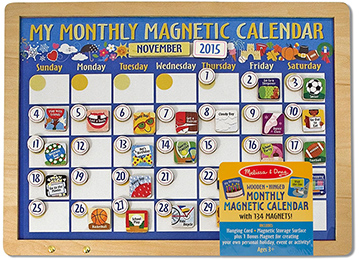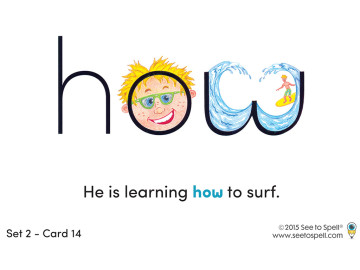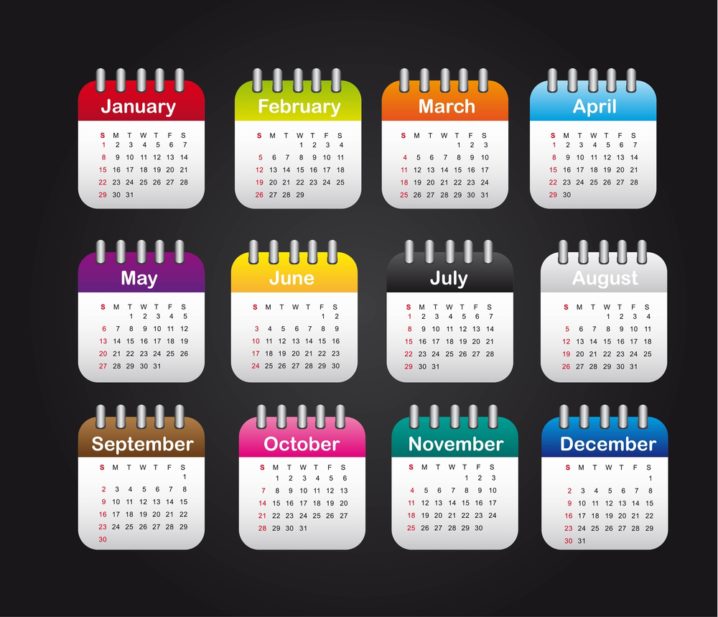Once your student has mastered the order of the days of the week, (see our recent post “How to Teach Kids with Dyslexia the Order of the Days of the Week”) they’re ready to learn the weeks and months of the year and to discover how a calendar is laid out.
In the process, they’ll also learn about the abstract concepts of ‘yesterday,’ ‘today’ and ‘tomorrow.’ Eventually, they’ll be able to recognize upcoming dates, learn which holidays are in each month and even appreciate the cycles of the weather.
Find a fun calendar to work with
To help your student learn about months, years and calendars, we recommend that you have a fun calendar to play with. We like the Melissa & Doug Deluxe Magnetic Calendar. It’s a dry-erase board and calendar board with 140 magnets. Your child can post the days of the week, dates, month, and year, and then fill the calendar boxes with multicolored magnets that represent holidays and activities.

We suggest that you start simple by storing all your extra magnet pieces in a container. Then use the white board as a chore chart or daily calendar activity board. You’ll have more room to fill in more detail.
(Note: If you have toddlers, be aware that this product might be a choking hazard since it comes with many small pieces.)
Start with the basics
Begin with calendar basics. Take time with your young student and describe how each week consists of 7 days, followed by another week.
Pick a day at the beginning of each month to sit down with your child and set up the calendar for that month. Identify the year, month, and dates.
If you’re working with a calendar like Melissa & Doug’s, load in the activity magnets and special event magnets. It helps to associate activities with the days that they occur. For example, if soccer practice is on Mondays and Wednesdays, write it in or use an activity magnet.
Then add magnets to represent the holidays in the month and to help your student anticipate upcoming holidays. If there’s a day or event without a matching magnet, write it in with your dry erase markers.
If possible, have your child practice with the calendar every day as he learns the days of the week.
Explore yesterday, today and tomorrow
It’s normal for dyslexic people to have a hard time with the concepts of of ‘yesterday,’ ‘today’ and ‘tomorrow.’ Use the calendar to help your student understand the difference between them.
Start with what ‘today’ means. Explain that ‘today’ represents the current day and talk about the day’s events and experiences.
Then describe ‘yesterday’ while pointing to the previous day on the calendar and talking about what happened that day.
Finally, talk about what ‘tomorrow’ means. Explain that ‘tomorrow’ comes after ‘today’ and talk about the activities that are planned for tomorrow.
Discover weekdays vs. weekends
Remember when you were a kid and every day seemed the same as the last? Help your child understand how we like to connect days into two groups: weekdays and weekends. Point out that kids typically go to school and parents typically go to work five days in a row: Mondays through Fridays. Talk about how Saturday and Sunday are the weekend and give examples of some things people like to do on weekends.
Remember: Review is always important when it comes to memorizing!
Look for our upcoming post: Use music to learn the order of the months
Bonus…….
If you found this post helpful, you might enjoy learning about a product that makes spelling sight words easier for dyslexic kids.
See to Spell Sight Words flashcards help students overcome the confusion of spelling common but tricky sight words. Our unique method is based on memory research and includes numerous strategic memory anchors that speed up the memorization process. If your child or student struggles with memorizing sight words, try our 7 free sample cards at no risk!

Click Here to Learn More About See to Spell & Sign Up to Get 7 Free Sample Cards


